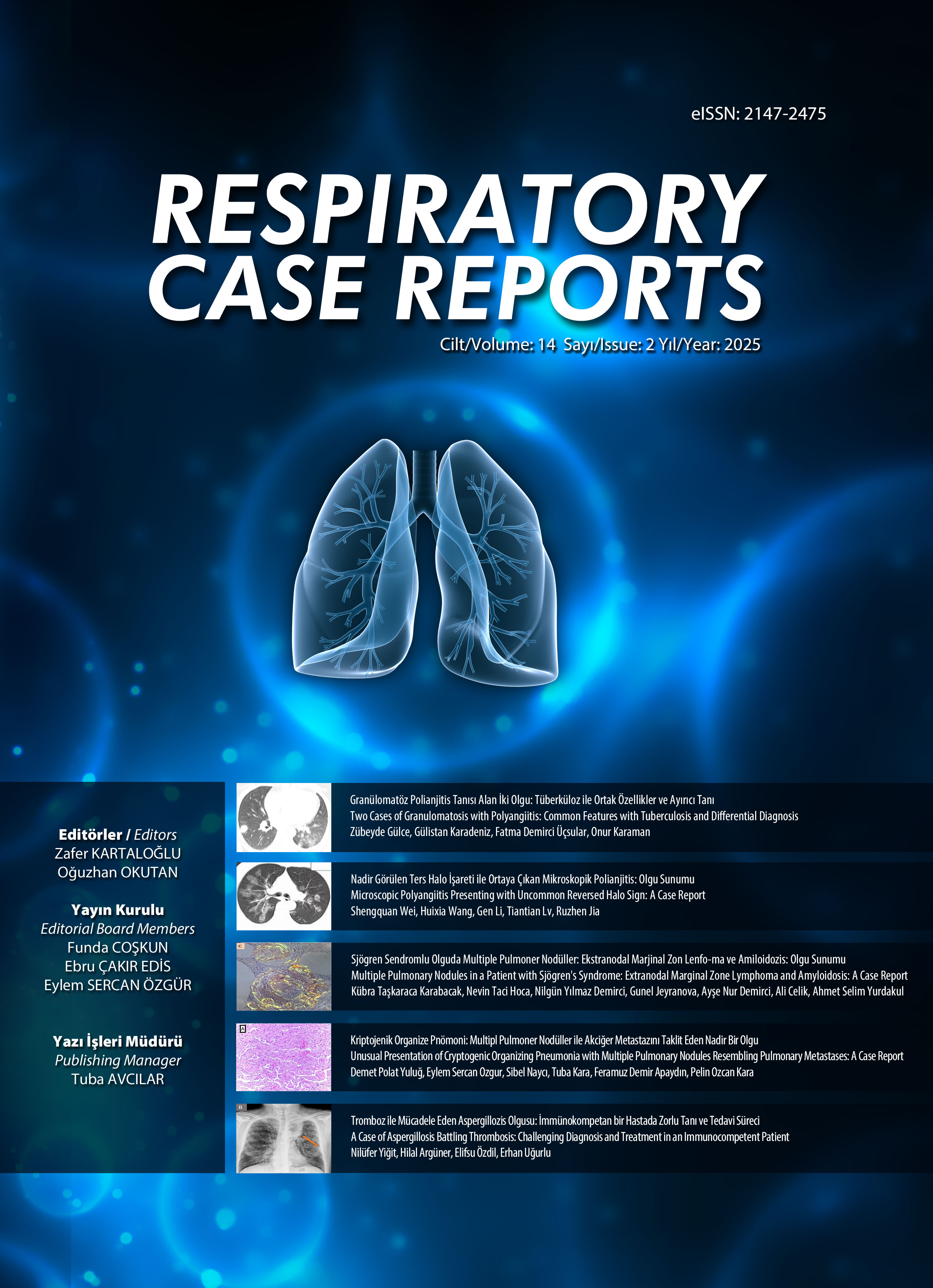e-ISSN 2147-2475

Volume: 7 Issue: 1 - February 2018
| CASE REPORT | |
| 1. | Hypersensitivity Pneumonitis Caused by Oyster Mushrooms: A Case of Mushroom Worker's Lung Taha Tahir Bekçi, Mustafa Çalık, Burcu Yalçın doi: 10.5505/respircase.2018.25901 Pages 1 - 4 The commercial production of mushrooms is often carried out in indoor areas and controlled environments with intense labor performed throughout the year. Indoor cultivation can lead to allergic symptoms, such as extrinsic allergic alveolitis, also known as hypersensitivity pneumonitis, in workers. A 23-year-old male patient's symptoms emerged after beginning to work in mushroom cultivation. The patient was admitted to the clinic with complaints of chills, fever, joint pain, and a skin rash. Based on his medical history and a physical and radiographical examination, the patient was diagnosed as hypersensitivity pneumonitis and medical therapy was initiated. The patient's symptoms dis-appeared within a few days and he was discharged at the end of the first week. Given the difficulties in the diagnosis of disease, the patients professional history should always be kept in mind as well as medical history, physical examination, and radiographic evaluation. |
| 2. | Patient Diagnosed with Organizing Pneumonia after Using Methotrexate for Psoriasis Fatih Uzer, Hülya Dirol, İrem Hicran Özbudak doi: 10.5505/respircase.2018.22932 Pages 5 - 8 Psoriasis is a recurrent chronic inflammatory skin disease. It affects some 2% of population. Despite the high incidence rate in the general population, pulmonary complications are rare. Presented here is a case of organizing pneumonia diagnosed in a patient using methotrexate for psoriasis. |
| 3. | Malignant Pleural Mesothelioma and Central Nervous System Metastases: Report of Two Cases Berna Akıncı Özyürek, Yurdanur Erdoğan, Meriç Ünver, Tuğçe Şahin Özdemirel, Funda Demirağ, Sadi Kaya doi: 10.5505/respircase.2018.82687 Pages 9 - 12 At the time of diagnosis of malignant pleural mesothelioma (MPM), distant metastases are rare, but can occur through the hematogenous route or an adjacent route. Central nervous system (CNS) metastasis is rarely seen and the incidence is not known. Metastases occur more often in patients with relatively prolonged survival following aggressive treatment. Metastasis most often occurs in the cerebral cortex, cerebellum, intracranial meninges, or the spinal cord. CNS metastases can be seen in all histological types of MPM. Presently described are the cases of 2 patients diagnosed with malignant mesothelioma and in whom a rarely seen cranial metastasis was determined. |
| 4. | Sarcoid-Like Reaction Mimicking Nodal Spread of Lung Cancer in a Silica-Exposed Patient on Positron Emission Tomography/Computed Tomography: A Case Report Feyza Şen, Ahmet Sami Bayram, Mehmet Karadağ, Elif Ülker Akyıldız doi: 10.5505/respircase.2018.33600 Pages 13 - 16 As a noninvasive modality, Fluorine-18 Fluorodeoxyglucose (FDG) positron emission tomography/computed tomography (PET/CT) is an important first step to assess mediastinal lymph node (LN) status in malignant pulmonary lesions. However, incorrect upstaging may occur due to false-positive results. Determining N stage is of utmost importance, and will affect the treatment planning strategy. Presently described is a staging challenge with PET/CT in a silica-exposed patient who was evaluated for characterization of a lung mass. The mass had an intense FDG uptake and proved to be squamous cell lung cancer (squamous cell carcinoma [SCC]) after a lobectomy. Histopathology revealed non-caseating granulomas representing sarcoidlike reaction (SLR) in non-calcified hypermetabolic mediastinal-hilar LNs. The significance of such reactions lies in how they can give a false impression of upstaging on the initial PET/CT or mimic disease progression after treatment. As an underlying clinical manifestation, occupational history is also discussed as a confounding factor for a benign cause of mediastinal lymphadenopathy. Awareness of tumor-related SLR is needed to avoid false positive PET/CT interpretation. To obtain histological confirmation of LNs for accurate staging in such a circumstance is also emphasized. |
| 5. | Ultrasonographic Visualization of an Aspirated Foreign Body in Lung Tissue Nalan Kozacı, Mustafa Avcı, Muharrem Özkaya doi: 10.5505/respircase.2018.65882 Pages 17 - 20 Ultrasonography is widely used for diagnostic purposes in emergency departments. The visualization of an aspirated foreign body and the surrounding inflammation using lung ultrasonography is described in this case report. |
| 6. | Descending Necrotizing Mediastinitis: Report of Two Cases Fatih Meteroğlu, Menduh Oruç, Atalay Şahin, Burak Gül, Gönül Ölmez Kavak doi: 10.5505/respircase.2018.46503 Pages 21 - 25 Descending necrotizing mediastinitis (DNM) is a rare but fatal progressive condition. DNM is infectious disease occurring in the tissues and structures of the mediastinum that spreads from the oral cavity and the neck. Unless it is diagnosed in a timely manner and properly treated, the outcome is fatal. Delay in treatment allows the infection to spread down to the mediastinum. Early diagnosis, appropriate antibiotherapy, and surgical intervention are necessary for a cure. Presently described are 2 cases: a 37-year-old man presenting with a fetid fluid discharge in his mouth ongoing for 5 days, and a 57-year-old man complaining of not being able to swallow after eating bony meat 7 days earlier. Both cases underwent surgery after the necessary laboratory and radiological procedures were performed in the emergency department. Though there was a delay in admission, both patients were discharged after an uneventful surgical intervention. |
| 7. | Ectopic Parathyroid Adenoma: A Rare Mediastinal Tumor Orkide Kutlu, Mustafa Çalık, Cevdet Duran, Hıdır Esme, Omer Karahan doi: 10.5505/respircase.2018.80958 Pages 26 - 29 Primary hyperparathyroidism is generally due to a solitary parathyroid adenoma and among those adenomas, 1% have been reported to have an ectopic mediastinal location. In the diagnosis of ectopic parathyroid adenoma, technetium-99m methoxyisobutylisonitrile scintigraphy is an imaging method with a sensitivity of approximately 100%; however, in preoperative localization of the tumor, it should be evaluated together with magnetic resonance imaging and/or computed tomography images. In general, the treatment necessitates a cervical approach that may require a sternotomy, though rarely, an anterolateral thoracotomy is warranted. Recently, especially in visceral tumors, an effective and comfortable treatment option has been defined with video assisted thoracoscopic surgery. The aim of this article was to report the successful excision of a mediastinal parathyroid adenoma with a lateral thoracotomic approach that was localized with Tc-99m MIBI scintigraphy and single-photon emission computed tomography imaging in a patient with ongoing clinical and laboratory findings of HPT after the first operation, in which a general surgical team performed a total thyroidectomy and parathyroidectomy. The patient is still in follow-up with L-thyroxine, calcium, and vitamin D replacement treatment. |
| 8. | Periosteal Chondroma of the Rib: An Unusual Location Cumhur Murat Tulay, Sadık Yaldız, Peyker Temiz doi: 10.5505/respircase.2018.15046 Pages 30 - 32 Periosteal chondroma is a rare, benign tumor of hyaline cartilage. Periosteal chondroma is commonly found in the metaphysis of long bones or the small, tubular bones of the hands and feet. Periosteal chondroma arising in the rib is an extremely rare event. Described is the case of a 55-year-old patient with periosteal chondroma of the rib found after more than 3 years of thoracic pain. |
| 9. | A Case of Chylothorax with Interesting Etiology Nalan Ogan, Evrim Eylem Akpınar, Tevfik Kaplan, Gökçe Türker, Meral Gülhan doi: 10.5505/respircase.2018.65807 Pages 33 - 35 Chylothorax occurs when chylous fluid from the lymphatic system accumulates in the pleural space due to damage to the ductus thoracicus. The milky fluid contains a high concentration of triglycerides in the form of chylomicrons. The initial test for diagnosis is analysis of the pleural fluid. It may be associated with a number of traumatic and nontraumatic conditions. Chylothorax was diagnosed in a patient who underwent an operation for a thoracic vertebra fracture 4 years earlier who presented with bronchitis. Fixation pins in the lower thoracic vertebra inserted in the operation were observed on thorax computerized tomography. No other etiological cause for chylothorax was found based on the patient history, physical examination, or advanced examinations. It was decided that the collapse and fracture operation had a late complication. This case is presented as an interesting etiological cause of chylothorax as, to our knowledge, there is no similar case in the literature. |
| 10. | Sarcoidosis Presenting with Pleural Involvement: A Case Report Ali Kadri Çırak, Zeynep Öndeş, Nur Yücel doi: 10.5505/respircase.2018.90532 Pages 36 - 40 Sarcoidosis is a multisystemic, granulomatous disease with particular involvement in the lungs and the intrathoracic lymph nodes. Pleural fluid has been reported to occur in 0% to 5% of the cases in the literature. Diagnosis depends on the presence of non-caseating granulomas in the biopsy sample and the exclusion of other possibilities. A 77-year-old woman with complaints of shortness of breath and a dry cough was found to have non-necrotizing granulomatous inflammation in pleural biopsy and computed tomography guided transthoracic Tru-Cut biopsy specimens. This was a rare case in which partial recovery was achieved through treatment with methylprednisolone for a year in reduced doses. |
| 11. | What, Where and How in Granulomatous Diseases? Tuğçe Gılman Oyman, Gülben Altan, Ayşe Baççıoğlu, Ayşe Füsun Kalpaklıoğlu doi: 10.5505/respircase.2018.54265 Pages 41 - 46 Granulomatous diseases of the lung may be difficult to diagnose in both pathological and clinical aspects. The most common reasons for granulomatous lung are tuberculosis as an infectious source, and sarcoidosis or hypersensitivity pneumonia (HP) as non-infectious causes. Here, 2 cases of granulomatous lung disease that had been incorrectly diagnosed are described. The first was a 64-year-old female patient diagnosed as HP clinically and radiologically, and the second was a 67-year-old male diagnosed as sarcoidosis pathologically. Both had progression clinically and radiologically under corticosteroid treatment. Repeat bronchoscopic evaluation revealed Mycobacterium tuberculosis in the bronchial lavage polymerase chain reaction/BACTEC (Becton Dickinson and Co., Franklin Lakes, NJ, USA) cultures, and lung tuberculosis treatment was initiated for both patients. These cases are interesting in that granulomatous diseases may have similarities in clinical, radiological, and pathological features, and repetition of tuberculosis microbiological examination is important in the differential diagnosis. |
| 12. | A Rare Cause of Acute Respiratory Failure: Myasthenic Crisis Mehmet Erdem Çakmak, Samet Er, Derya Ademoğlu, Hayriye Cankar Dal, Sema Sarı, Büşra Tezcan, Dilek Kazancı, Sema Turan doi: 10.5505/respircase.2018.65902 Pages 47 - 49 Myasthenia gravis is a muscle disorder characterized by weakness and rapid fatigue in the skeletal muscles. Myasthenic crisis can develop for various reasons. In this case report, a patient with respiratory distress and a myasthenic crisis who required urgent hospital admission and intensive care unit is described. He had a history of diabetes mellitus, hypertension, coronary artery bypass graft surgery, and a thymectomy due to myasthenia gravis. The patient required mechanical ventilator support in the intensive care unit as a result of acute respiratory failure due to myasthenic crisis. Pyridostigmine 120 mg 3x1 and 1 mg/kg/day prednisolone were administered. Intravenous immunoglobulin was given at a dose of 2 g/kg for 5 days. The patient was removed from the mechanical ventilator on the third day of the intensive care admission. This case is presented as myasthenic crisis as a rare cause of acute respiratory failure. |
| 13. | Congenital Lobar Emphysema Pınar Mutlu, Merve Ilcın Guven doi: 10.5505/respircase.2018.55707 Pages 50 - 53 Congenital lobar emphysema is defined by hyperinflation of 1 or more lung lobes in the absence of extrinsic bronchial obstruction. It is a very rare condition with an incidence of 1 in 20,000 to 30,000 births. The etiology is unknown in 50% of cases. Other factors suspected in the etiology are bronchial abnormalities or alveolar defects. Some theories also include bronchial collapse as a result of insufficient cartilage support. The left upper lobe is frequently affected, followed by the middle and right upper lobes, while the lower lobes are rarely affected. Some 90% of cases are diagnosed in infancy with severe respiratory symptoms. In this report, a case of congenital lobar emphysema diagnosed in adulthood is described. |











